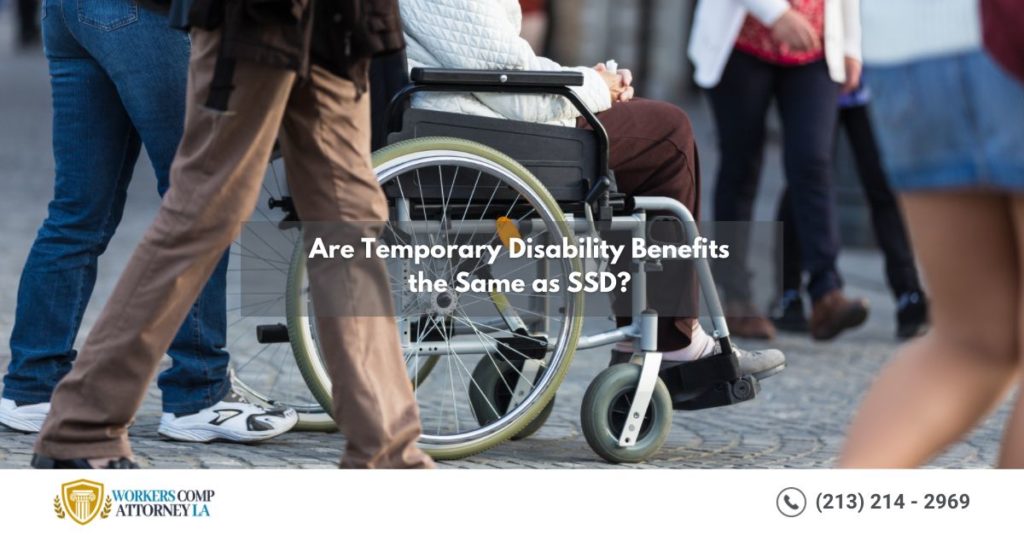Temporary disability benefits are not considered the same as social security disability (SSD), as the Social Security Administration (SSA) only covers disabilities of a permanent nature, not work-related injuries that are considered short-term.
Making the Distinction: Temporary Disability Benefits versus Social Security Disability Benefits
It’s important to distinguish what constitutes temporary disability benefits and what the Social Security Administration deems to be an SSD or social security disability. Usually, a temporary disability is covered by workers’ compensation claims.
Social Security disability programs cover permanent disabilities, not temporary impairments. Therefore, disabilities are either categorized as temporary or permanent and are based on the length of the condition and the type of plan governing the injury or illness.

What is a Temporary Disability?
A temporary disability is normally defined as a disability that lasts a short time. This condition may affect you for a few days, a couple months, or several years. However, the expectation is that you’ll eventually recover.
The injury or condition may hamper you from taking part in daily activities without assistance. These activities may include showering, working, or walking.
For instance a sprain or broken leg may be considered a temporary disability, and therefore may fall under the category of temporary disability benefits. A torn ligament or concussion may also be included under this classification.
A temporary disability may only partly hinder a person from doing their job. Usually, the receipt of these benefits involves receiving checks weekly or biweekly for about two-thirds of the claimant’s salary.
According to Nolo, workers receiving temporary total disability (TTD) payments usually receive the money after they’ve been out of work for about three to seven days. If you’ve been out of work for a longer time–about 14 to 21 days–you’ll receive the compensation from the date you were first disabled.
Temporary disability benefits are listed as total temporary disability (TTD) benefits or as temporary partial disability (TPD) benefits, also called wage-loss TD. Both payment types compensate the claimant for lost earnings when they’re recovering from a work-related illness or injury.
The total compensation paid for a temporary disability usually covers the patient’s medical expenses, lost earnings, or the temporary use of a medical aid, such as a wheelchair or crutches.
A person receiving SSDI benefits for a permanent disability may receive compensation to cover the above-mentioned costs as well as the estimated earnings they will lose from exiting the workforce.
A permanent disability, or an impairment covered under SSDI benefits, is one where the patient experiences the inability to function in routine activities. The compensation covers the costs associated with the illnesses or injuries from which the patient is not expected to recover.
The recipient may be born with a disability that is permanent or they may become permanently disabled after an accident. Permanent disabilities may be combined with long-term disabilities – or conditions where the patient may recover. For example, cancer may be listed as a long-term disability under the SSA.
The time frame that distinguishes a temporary disability from a permanent disability is typically one year. However, some people who have temporary disabilities may receive compensation for longer than a year. Alternatively, some patients who have permanent disabilities may receive SSDI benefits for less than a year if they are expected to die from their impairment or injury.
How Workers’ Compensation Plans Are Set Up
Most workers’ compensation plans are designed to cover temporary disabilities that result from accidents at work. The Social Security Administration or SSA only covers long-term disabilities that prevent workers from earning an income for over a year.
Therefore, to qualify for SSD benefits, the claimant must have a condition that the SSA considers disabling. To arrive at a conclusion, the SSA uses a reference called a Blue Book to see if a person’s condition qualifies for benefits.
To determine eligibility, the SSA defines a disability based on the claimant’s incapacity to work in the job they previously did and if they can make any adjustments in this regard. SSD benefits also factor in how long the disability is expected to last or if the condition will result in death.
A temporary disability, which is usually related to a worker’s employment, may result from a work-related injury or medical condition, such as a respiratory illness, that originated on the job.
From the above definition, it is clear that workers’ compensation insurance may cover temporary disabilities but SSDI benefits do not cover conditions or impairments temporary in nature.
Moreover, the SSA does not factor in whether the disability happened on the job or outside of a person’s employment.
Permanent disabilities, as noted, are expected to last the lifetime of the patient. While some of the disabilities are totally disabling some are classified as partly disabling.
Examples of Long-term and Permanent Disabilities
Long-term disabilities and permanent disabilities may include conditions, such as paralysis, traumatic brain injuries, cancer, heart disease, depression, HIV, obsessive-compulsive disorder, or conditions that began at birth such as cerebral palsy.
Some disabilities may only prevent you from working. For example, a person who suffers paralysis may not be able to lift boxes or work in a warehouse as they once did. However, they may eventually be able to work at a desk job if they recover sufficiently.
On the other hand, some permanent disabilities may take a person out of commission for a short time, such as a condition like post-traumatic stress disorder or a physical condition like lupus.
SSDI benefits represent the primary permanent and long-term disability program that the Social Security Administration (SSA) oversees.
Therefore, some of the conditions listed under this program–although long-term–may only involve temporary flare-ups. For example, a person who has multiple sclerosis (MS) might not work for several days because of problems with concentration. However, they may be able to work other days without difficulty.
As a result, SSDI benefits can be adapted so people receive some type of income while working part-time while receiving benefits. This means you can still receive an income for working up to a certain salary allocation per month, also referred to as substantial gainful activity (SGA).
Learn More about Your Rights for Receiving Disability Benefits
Get the answers you need about temporary disability benefits or SSDI benefits by speaking to a qualified legal representative. Contact Workers Comp Attorney LA right now, or Belal Hamideh Law at (562) 526-1224 today.









